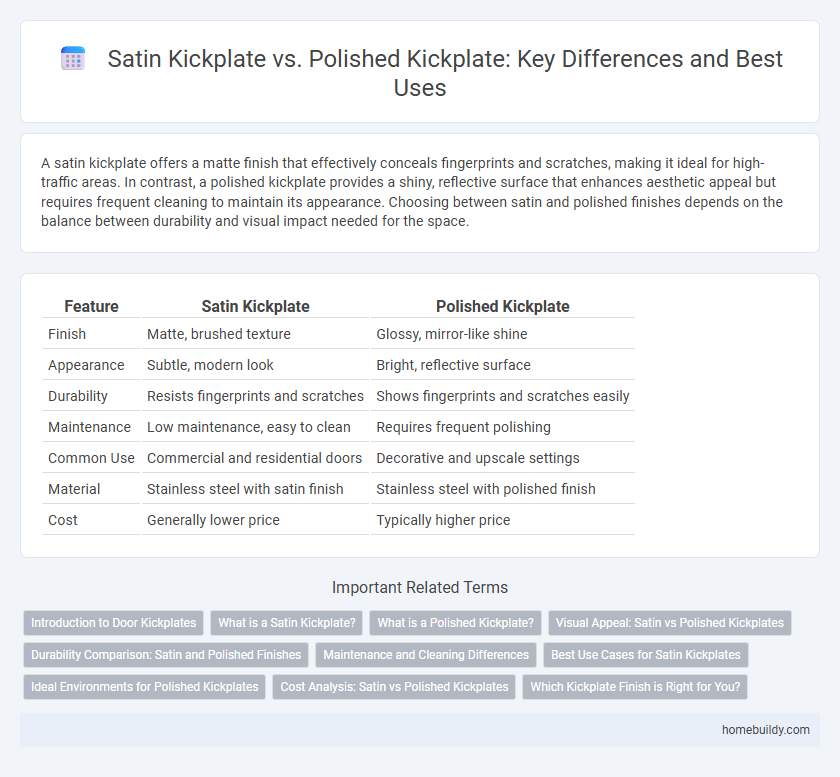A satin kickplate offers a matte finish that effectively conceals fingerprints and scratches, making it ideal for high-traffic areas. In contrast, a polished kickplate provides a shiny, reflective surface that enhances aesthetic appeal but requires frequent cleaning to maintain its appearance. Choosing between satin and polished finishes depends on the balance between durability and visual impact needed for the space.
Table of Comparison
| Feature | Satin Kickplate | Polished Kickplate |
|---|---|---|
| Finish | Matte, brushed texture | Glossy, mirror-like shine |
| Appearance | Subtle, modern look | Bright, reflective surface |
| Durability | Resists fingerprints and scratches | Shows fingerprints and scratches easily |
| Maintenance | Low maintenance, easy to clean | Requires frequent polishing |
| Common Use | Commercial and residential doors | Decorative and upscale settings |
| Material | Stainless steel with satin finish | Stainless steel with polished finish |
| Cost | Generally lower price | Typically higher price |
Introduction to Door Kickplates
Door kickplates protect lower door surfaces from damage and wear in high-traffic areas. Satin kickplates offer a subtle, matte finish that hides fingerprints and scratches, while polished kickplates provide a shiny, reflective surface that enhances aesthetic appeal. Choosing between satin and polished depends on the desired balance between maintenance and visual impact in commercial or residential settings.
What is a Satin Kickplate?
A satin kickplate features a brushed metal finish that reduces glare and fingerprints, providing a sleek, understated appearance ideal for high-traffic areas. Unlike polished kickplates, which have a reflective, mirror-like surface, satin finishes offer greater durability and conceal wear and tear more effectively. Commonly made from stainless steel or aluminum, satin kickplates enhance door protection while maintaining a modern, professional look.
What is a Polished Kickplate?
A polished kickplate features a highly reflective, mirror-like finish achieved through extensive buffing and polishing, typically made from stainless steel, brass, or aluminum. This finish enhances aesthetic appeal and provides durable protection against scuffs and impacts on doors in high-traffic areas. Polished kickplates resist corrosion and wear, making them ideal for commercial and residential applications requiring both functionality and elegant appearance.
Visual Appeal: Satin vs Polished Kickplates
Satin kickplates offer a smooth, matte finish that minimizes fingerprints and smudges, providing a subtle, modern appearance ideal for contemporary interiors. Polished kickplates deliver a reflective, shiny surface that enhances visual brightness and creates a striking, luxurious look, perfect for upscale or traditional settings. Choosing between satin and polished finishes depends on the desired balance between low maintenance and high-gloss aesthetic impact in door hardware design.
Durability Comparison: Satin and Polished Finishes
Satin kickplates offer superior resistance to scratches and fingerprints due to their matte finish, making them ideal for high-traffic areas requiring durable protection. Polished kickplates, while visually striking with a shiny, reflective surface, are more prone to visible smudges and minor abrasions, which can reduce their longevity in heavy use environments. Both finishes are typically made from stainless steel, but satin finishes maintain a cleaner appearance and better durability over time under rigorous conditions.
Maintenance and Cleaning Differences
Satin kickplates require less frequent cleaning due to their matte finish, which conceals fingerprints and smudges more effectively than polished surfaces. Polished kickplates, while offering a shiny and reflective appearance, demand regular polishing and careful maintenance to prevent fingerprints, scratches, and tarnishing. Choosing satin kickplates reduces long-term upkeep efforts and preserves a clean look in high-traffic areas.
Best Use Cases for Satin Kickplates
Satin kickplates are ideal for high-traffic areas where durability and resistance to fingerprints are essential, such as commercial buildings, hospitals, and schools. Their matte finish conceals scratches and smudges better than polished kickplates, maintaining a cleaner appearance over time. Satin kickplates offer a practical solution for environments requiring both protection and low maintenance without sacrificing aesthetics.
Ideal Environments for Polished Kickplates
Polished kickplates are best suited for high-traffic commercial spaces such as hotels, upscale retail stores, and office lobbies where aesthetics and durability are essential. Their reflective surface enhances visual appeal while resisting scratches and corrosion in heavily used doorways. These kickplates maintain a pristine appearance in environments that prioritize elegance and frequent cleaning.
Cost Analysis: Satin vs Polished Kickplates
Satin kickplates generally cost less than polished kickplates due to simpler finishing processes and reduced labor intensity. Polished kickplates require additional polishing steps and higher-grade materials, increasing both production time and expense. Choosing satin kickplates offers budget-friendly durability while polished options provide premium aesthetics at a higher price point.
Which Kickplate Finish is Right for You?
Satin kickplates offer a muted, matte finish that resists fingerprints and scratches, making them ideal for high-traffic areas and commercial use. Polished kickplates provide a shiny, reflective surface that enhances aesthetic appeal but may require more frequent cleaning to maintain their appearance. Choosing between satin and polished finishes depends on your preference for maintenance ease versus visual impact and the environment where the door kickplate will be installed.
Satin kickplate vs polished kickplate Infographic

 homebuildy.com
homebuildy.com